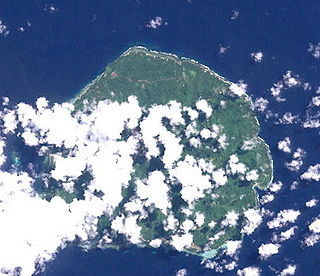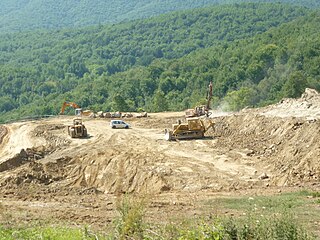
Eldorado Gold Corporation is a Canadian company that owns and operates gold mines in Turkey, Greece and Canada. Since its merger with European Goldfields in 2011 the company has been pursuing the development of the Skouries mine, Olympias mine and Stratoni mine in Greece. The company previously developed and operated gold mines in China, Brazil and Mexico. Headquartered in Vancouver and listed on the Toronto and New York Stock Exchanges, Eldorado Gold has developed and operated assets from several merged companies HRC Developments Corporation, Afcan Mining Corporation, Sino Gold Mining, Brazauro Resources, Integra Gold, as well as European Goldfields.

Simberi Island is a volcanic island in the Tabar Group, in Papua New Guinea's New Ireland Province.
Silver mining in Nevada, a state of the United States, began in 1858 with the discovery of the Comstock Lode, the first major silver-mining district in the United States. Nevada calls itself the "Silver State." Nevada is the nation's second-largest producer of silver, after Alaska. In 2014 Nevada produced 10.93 million troy ounces of silver, of which 6.74 million ounces were as a byproduct of the mining of gold. The largest byproducers were the Hycroft Mine, the Phoenix Mine, the Midas Mine and Round Mountain.

Wiluna Gold Mine is an active gold mine operated by Wiluna Mining Corporation near the town of Wiluna, 940 kilometres (580 mi) north of Perth in Western Australia's Goldfields region. Wiluna is one of the Goldfield's great mining centres, with historical production plus current resources of more than 310 tonnes.
Gold mining in Alaska, a state of the United States, has been a major industry and impetus for exploration and settlement since a few years after the United States acquired the territory in 1867 from the Russian Empire. Russian explorers discovered placer gold in the Kenai River in 1848, but no gold was produced. Gold mining started in 1870 from placers southeast of Juneau, Alaska.
Coeur Mining, Inc. is a precious metals mining company listed on the New York Stock exchange. It operates five mines located in North America. Coeur employs 2,200 people and in 2012 it was the world's 9th largest silver producer. In 2013 the company changed its name to Coeur Mining, Inc. from Coeur d'Alene Mines and moved its head office to Chicago, Illinois from Coeur d'Alene, Idaho.
There are different methods by which gold mining companies are ranked. One is by their annual production. Another is by their cash cost per ounce, that is, how much money it costs them to mine the gold. Since gold prices are the same everywhere, companies with lower costs per ounce make more profit. The most common method lists by market capitalization which considers the total value of capital holdings by that company. Also considered when comparing companies is their market capitalization per ounce of gold equivalent which takes the market value and total reserves and resources for each company as well as the price of gold into consideration. The figures for each company can be used to determine the value the stock market gives to each company's reserves on an ounce to ounce basis.

Goldstrike is a gold mine in Eureka County in north-eastern Nevada. It is located on the Carlin Trend, a prolific gold mining district. It is owned and operated by Barrick Gold. Since Barrick acquired Goldstrike in 1986, until 2018 it produced 44.4 million ounces of gold.
The Colnic mine is a large open pit mine in the west of Romania in Hunedoara County, 30 km north of Deva and 400 km north of the capital, Bucharest. Colnic represents a large gold and copper deposit with estimated reserves of 2.15 million oz of gold and 135,000 tonnes of copper. The project is owned by the Toronto-based company Carpathian Gold.
The Cireșata mine is a large open pit mine in the west of Romania in Hunedoara County, 30 km (19 mi) north of Deva and 400 km (250 mi) northwest of the capital, Bucharest. Cireșata represents a large gold and copper deposit with estimated reserves of 4.18 million oz of gold and 174.4 million tonnes of copper ore grading 0.15% copper. The project is owned by the Toronto-based company Carpathian Gold.
Wheaton Precious Metals Corp. is a Canadian multinational precious metals streaming company. It produces over 26 million ounces and sells over 29 million ounces of silver mined by other companies as a by-product of their main operations.
The Frasin mine is a large open pit mine in the west of Romania in Alba County, 73 km west of Alba Iulia and 467 km north-west of the capital, Bucharest. Frasin represents a large gold deposit with estimated reserves of 1 million oz of gold and 2.96 million oz of silver. The project is owned by the Toronto-based company Gabriel Resources.
The Rodu mine is a large open pit mine in the west of Romania in Alba County, 73 km west of Alba Iulia and 467 km north-west of the capital, Bucharest. Rodu represents a large gold deposit with estimated reserves of 0.81 million oz of gold and 1.7 million oz of silver. The project is owned by the Toronto-based company Gabriel Resources.
European Goldfields Ltd. was an EU-focused, Whitehorse based Canadian precious metals company engaged in gold, silver and copper exploration, development and production. The mining rights it owned to land in Greece, Romania and Turkey gave it access to over 10 million ounces of 2P gold reserves in addition to over 80 million ounces of silver.

First Majestic Silver Corp. is a Canadian silver-mining company that operates in Mexico and the United States. It has four producing mines under its control: San Dimas Silver/Gold Mine, Santa Elena Silver/Gold Mine, La Encantada Silver Mine, and Jerritt Canyon Gold Mine. First Majestic also produces and sells its own bullion rounds and bars.

Tahoe Resources Inc. was a mining company and intermediate precious metals producer with silver and gold mines in Canada, Guatemala and Peru. It was founded in Vancouver, British Columbia by Kevin McArthur, former CEO of Glamis Gold and Goldcorp. Incorporated in British Columbia, Canada, the company's U.S. headquarters is located in Reno, Nevada.
The Olympias mine is a previously producing gold-silver-lead-zinc mine located in the Halkidiki Peninsula in northern Greece. It was on care and maintenance between 1995-2010 and is currently under redevelopment by Eldorado Gold. Production is targeted in Q1 2017.

The Skouries mine is a high-grade gold-copper porphyry deposit located in the Chalkidiki peninsula in northern Greece. It is currently under development by Eldorado Gold and is planned to be an open pit and underground mine. Production is targeted in 2019.
The 1971 Certej dam failure was a flood due to the failure of a tailings dam at the Certej mine which led to the death of 89 people. It occurred on 30 October 1971 in Certeju de Sus commune, Hunedoara County, Romania.
Gold cyanidation is a chemical process for extracting gold from low-grade ore. Used in Romania for decades, the process came into debate following the 2000 Baia Mare cyanide spill and proposal of the Roșia Montană Project, which would create the largest operation for gold extraction using cyanides in Europe.







